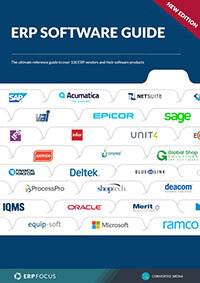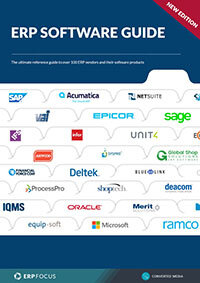Are you ready for low-code ERP?
Enterprise Resource Planning (ERP) had been around for over 100 years. It started as a manual process and has evolved and gone through several technology transitions over the years; from on-premise system to cloud ERP. Today, there is a wide spectrum of ERP technologies, some more than 20 years old, servicing companies around the globe.
Despite the many virtues of cloud ERP, many companies still run old, on-premises or hosted ERP applications, and are stuck on old software versions because they are so difficult to change and upgrade.
If the ERP system in your business is outdated, it’s probably not keeping up with the pace of your business. Too hard, too expensive to update? It may be time to consider the latest iteration in ERP technology called low-code ERP. To fully understand what low-code ERP is, and its benefits, let’s look at the various ERP technologies used by companies today.
Modern ERP began primarily as an on-premises based computing system and is still used in that manner by many companies today. With on-premises systems, a company’s IT department manages their own computing hardware and the underlying technology stack that ERP sits on, including operating systems, databases, security software, reporting tools, and other utilities. Overall, ERP from this era was, and still is, IT intensive. It typically requires technical people to make ERP changes and upgrades.
To help alleviate some of the IT burden, ERP hosting providers came to market with their own data centers or data center services like Amazon. In this model, they hosted essentially the same ERP software, but the provider managed the hardware and sometimes the underlying software stack to minimize IT operations costs. Because the hosted ERP software was fundamentally the same, it was still technically difficult to change and upgrade. Nevertheless, it was provided over the internet using tools like Citrix or other remote desktop software to give users access outside their premises. Hosting solved some, but not all of the IT intensive issues with ERP.
As cloud technology evolved, new cloud ERP software applications appeared on the scene that eliminated the need for companies to manage or even see the underlying software stack. ERP was delivered “as a service” like electricity or water. This allowed companies to focus more on the ERP applications and less on the IT plumbing that supported it. Depending on the cloud ERP product, these applications were easier to implement and much easier to upgrade and change over time. This overcame a significant limitation of older on-premise and hosted applications.
However, many hosting and ERP software providers introduced “cloud ERP” applications that were just a repackaging of old products. This created misperception in the market and is one reason why ERP buyers are still confused about the differences between hosted vs real Cloud ERP. To this day, one of the top read pages on Rootstock’s web site is the difference between cloud and hosted ERP.
The difference between modern cloud ERP application vs hosted ERP will soon become more evident to everyone with the recent arrival of the next generation of low-code ERP cloud applications. That’s the subject of our upcoming webinar: what is low-code ERP and why do you need it now? Low-code ERP further addresses the over-reliance companies have on IT and puts more power in the hands of businesspeople to make changes and to customize ERP. That’s right, now you can customize ERP for your company and not suffer for it.
Low-code technology empowers business users to easily create their own apps, change screens, change processes, add AI and analytics – and still continue to take on new software upgrades. Low-code ERP apps are highly configurable, but also allow users to go beyond what an ERP software vendor is delivering “out of the box.” The speed in which companies can innovate and impact operations is improved dramatically because business users can make these changes to fine-tune ERP without being a burden on IT. And unlike legacy ERP systems, you can tailor ERP for your company without getting locked into old software releasees.
Low-code is not the latest software fad. The trend toward low-code environments has been identified by all the major industry analyst firms. In a January 2020 report on ERP-enabled transformation, Gartner wrote “ERP is shifting to enterprise applications complemented by an ecosystem that includes new capabilities for application platforms, integration and low-code/no-code development. Gartner refers to this new era of ERP as ‘enterprise business capabilities’ (EBC).” It added that EBC, as an ERP suite surrounded by a platform, “facilitates the rapid development and adoption of new applications and capabilities.”[1]
Low-code ERP comes at a time when businesses desperately need the ability to be more agile and use ERP software to differentiate their business. The pace of business and the ability to adjust business models, product mixes, and add new customer services has never been so intense. Old ERP systems simply can’t cut it anymore, especially in this new world of remote workforces.
To learn more about low-code technology works and how it impacts ERP, join Peter Coffee, Salesforce’s VP of Strategic Research, and I as we discuss where this exciting new technology is heading and how it can impact your business. Tyler Smith, Senior Software Advisor for ERP Focus will also moderate a live Q&A session. Join us on Thursday, September 24th at 1 p.m. ET What is Low-Code ERP and Why Do You Need It Now?
1Gartner Report, “2020 ERP Predicts: Unprecedented Changes in ERP Enable Transformation, January 13, 2020.”
Free white paper

ERP Software Guide
A 70 page guide covering over 100 different software products

Related articles
-
![Mobile ERP case studies you can learn from [Image by javi indy on Freepik] Mobile ERP case studies you can learn from [Image by javi indy on Freepik]](/pictures/W1siZiIsIjIwMjQvMTAvMTYvejB2YnNremFyX01vYmlsZV9FUlBfY2FzZV9zdHVkaWVzX3lvdV9jYW5fbGVhcm5fZnJvbV9JbWFnZV9ieV9qYXZpX2luZHlfb25fRnJlZXBpa18uanBnIl0sWyJwIiwidGh1bWIiLCI0MDB4MjY2IyJdLFsicCIsImVuY29kZSIsImpwZyIsIi1xdWFsaXR5IDg1Il1d/Mobile%20ERP%20case%20studies%20you%20can%20learn%20from%20%5BImage%20by%20javi%20indy%20on%20Freepik%5D.jpg?sha=d39d01df11779155)
Mobile ERP case studies you can learn from
Learn how mobile ERP has benefited three businesses...
-

Secret KPI: Why Your ERP Implementation Team Matters More Than Software
Learn how Godlan ensures successful ERP implementation for manufacturers with proven strategies &...
-

How ERP software is addressing the challenges of new business models
How does ERP need to adapt to modern businesses to stay relevant?

